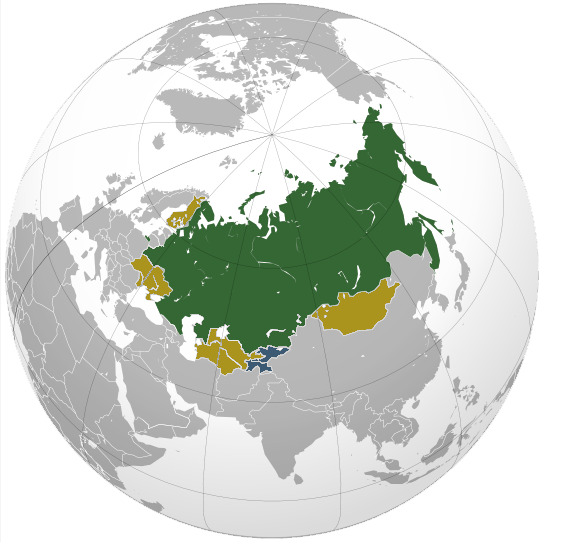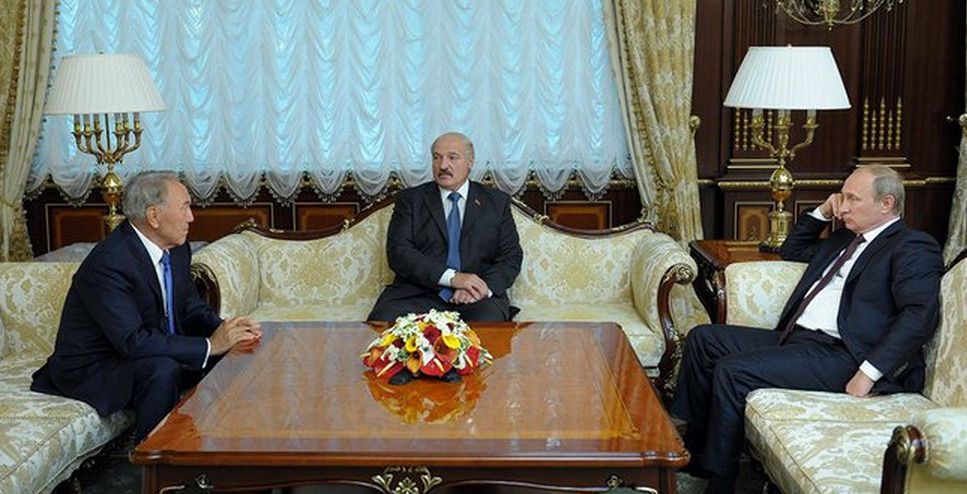
Despite sanctions imposed by the West and the falling value of the ruble, President Vladimir Putin had every reason to celebrate the beginning of the new year since the treaty of the long-awaited Eurasian Economic Union (also known as the EEU or the Eurasian Union) entered into force on January 1, 2015. Also, the leaders of the three member-states, Belarus, Kazakhstan and Russia, joined the celebrations by calling the “birth” of the Union a historic moment and the beginning of a new “epoch”. The president of Belarus, Alexander Lukashenko, expressed his great expectations towards the Union as the “foundation for the future of political, military, and humanitarian unity”. Only Ukraine did not join the celebrations, since its prospective EEU membership was negated by the government’s regime change. But how promising is the EEU really? How bright is the future of the Union given the ongoing Ukraine Crisis and EU sanctions on Russia and Ukrainian officials?
When looking at more Western-oriented analyses, a clear divergence in the assessment of the EEU’s potential success becomes apparent. In contrast to the idealized portrayal of the Union in the East, the West seems rather negative about the EEU. In order to take a critical stance towards the current discourse and gain a deeper understanding of the situation, it is important to look at both sides, EU and Russia, as well as the region that is between the two players – in this case, the current (Belarus, Kazakhstan and Russia) and to-be member-states (Armenia and Kyrgyzstan). An analysis of the diversity of their expressed commitments to the EEU is highly valuable in comprehending the EEU’s potential.
A Brief History of the EEU’s Creation
After several failed initiatives to create political and economic ties among each other, Belarus, Kazakhstan and Russia finally were successful in creating the Custom Union in 2010.[1] After the collapse of the Soviet Union, the Commonwealth of Independent States (CIS) was established in 1991 to bind the then independent states with economic and political ties.[2] This organization, however, quickly turned into a ‘pick and mix’ system allowing CIS- critical member-states to limit their commitment. This was undesired but tolerated by Moscow, since it was dependent on the member-states to stay with the CIS and Russia in the face of the EU’s formation and increased NATO and US involvement in the region.[3] While the CIS’s institutional framework stayed relatively ineffective, Russia, Belarus and Kazakhstan (later also Kyrgyzstan and Tajikistan) created a customs union in 1995 to foster multilateral economic integration. Customs Unions are free trade areas, usually with a common export tariffs, serving to increase economic efficiency and solidify ties. The Eurasian Customs Union (ECU) came into existence in 2010; meanwhile, further strategies for deeper economic and political integration were made. After Putin became president in 2000, he initiated the establishment of the EEU, most similar to the EU, with a strong institutional setup and more mutual obligations between member-states.[4]
From Putin’s speeches on foreign policy, it becomes apparent that he attempts to increase his influence in other countries through incentivizing partnerships and creating shared interests as opposed to the zero-sum thinking during the Yeltsin era.[5] Putin’s pragmatic politics have proven successful to the extent that Russia’s leverage in countries such as Ukraine, under Yanukovych prior to the Ukraine Crisis, had grown and the EEU has finally come into existence in 2015.[6] However, the countries that are part of the CIS and the ECU (Russia, Belarus, Kazakhstan, Armenia and Kyrgyzstan) partly overlap with the EU’s Eastern Partnership (EaP) and European Neighborhood Policy (ENP). The term ‘shared neighborhood’ captures the still dominant notion of competition for influence and alliances.[7] Another phrase used by scholars in this discourse, ‘normative rivalry’ between the EU and Russia, suggests that there is a struggle for spheres of influence between the two parties.[8]
The political discourse within the EU is normative and liberal, whereas the discourse within Russia is rather pragmatic and non-ideological. At the same time, it is up to the ‘shared neighborhood’ itself to decide upon which paradigm to operate and with which partnerships to engage.
The Current Member-States of the EEU
Nazarbayev expressed strong reservations regarding Kazakhstan’s commitment to political integration through the EEU, considering the potential of a loss of national sovereignty to Russia. Therefore, he insisted on limiting the EEU to a solely economic union and is openly criticizing Moscow for ‘politicizing’ it. Kazakhstan’s foreign minister Erlan Idrissov stated in an interview with Foreign Policy that his country will not take any side – Russian, Chinese, European, or American – but rather be pragmatic and instrumental about its future agreements with both the EU and Russia. These statements suggest that Kazakhstan opposes a future reintegration in the ‘Soviet space’. At the same time, it rejects the idea of politically committing and being bound to any party. Therefore, according to official statements, economic benefit would outweigh political pressure.
The current member-states will have to ask themselves three questions: Which of the parties (EU or EEU) is most economically promising? How likely is integration with the EU or EEU to be limited to economic and not political ties? And, would moving from one union to the other for economic interests be feasible for Kazakhstan (and Belarus), considering Russia’s pressure to build a united EEU?
While politicians and analysts deal with finding answers to those broad questions, let us look at the recent economic development in Kazakhstan and Belarus regarding integration with both Russia and the EU.

Moscow is providing large financial support to Belarus and has agreed to a future common oil market by 2025 as the main incentives for EEU membership. For Minsk, a stable oil import as well as the availability of loans from Moscow is central to its membership in the EEU. Until the common oil market is established in 2025, Russia will send an additional $1.5 billion (2% of Belarus’ GDP) to Belarus. In 2014, Putin pushed for the launching of the EEU, partly due to the Ukraine Crisis and falling international standing. Therefore, Minsk could negotiate highly favorable conditions in respect of duties. However, the conditions of the duties are renegotiated yearly and are estimated to soon become less advantageous for Russia’s partners, now that the EEU is launched. According to the European Council on Foreign Relations, Minsk’s hopes of the EEU being more effective than previous initiatives are soon to be dashed. Russia prohibited export to Russia for 23 companies and custom checks were reestablished at their borders. Further embargoes were imposed on agricultural goods from Belarus to Russia after accusations against Minsk to re-export goods originating from the EU to Russia. While Russia’s political resentment towards EU goods is obvious, Lukashenko claimed Russia’s embargo legally ‘groundless’.
For Kazakhstan, the economic perspectives in the context of its EEU membership look brighter, though not flawless. The opening of the Russian and Belarusian market for Kazakh businesses, transport routes connecting Europe and Asia, and free flow of workers, services and finances are promising factors in its EEU membership. Nevertheless, in late 2013, already during the existence of the EEU, Kazakhstan’s exports fell by $7 billion while imports from the ECU rose by $17 billion.[9] Furthermore, Nazarbayev complained about the inaccessibility of Russia’s electricity market as well as limitations to meat exports and electricity transit.[10] The negative economic impact of the ECU for Kazakhstan is a sign of its future with the EEU, suggesting that its membership may turn out rather disadvantageous than beneficial for its own economy.
Further integration in the EEU can’t be expected to change much in Russia’s rigid policies and limitations to trade. Putin is very likely to tighten regulations within the EEU to EU-exclusive policies. This is most likely to not be in the other member-states’ interests. A limitation to Moscow’s domination within the EEU framework is the decision-making process within it. In the Eurasian Commission today, decisions must be made with unanimity.[11] However, the power distribution within the EEU remains uncertain. What is clear is the current member-states’ (especially Kazakhstan’s) resolve not to tolerate Russia’s political leverage in the territory and not to silently accept policies disadvantageous to their economies.
Troubling Times for the Russian Ruble and Alternatives to EU and EEU
The currently sinking value of the Russian ruble and Russia’s decreasing reputation in the West should be seen as warnings to countries that engage in exclusive partnerships with Russia. Closer economic integration and trade in the ruble bears greater risks to be mutually effected by economic recession or crises. Two factors have contributed to the falling value of the ruble: declining oil prices and the ongoing Ukraine Crisis including sanctions from the EU. The failed OPEC negotiations to reduce the production level of oil are the main cause for the oil slump toward the end of 2014 and early 2015. Due to the low prices of $50 instead of $100 per barrel for more than only a few months, Anton Siluanov, Russia’s finance minister, announced a loss of $45 billion (20% of the planned revenues). Russia’s GDP is expected to shrink by 3% to 5% in 2015.
Already early in January 2015, Lukashenko voiced concerns about his country’s high dependency on exports to Russia and its currency’s attachment to the Russian ruble. The Belarusian president distanced himself from further commitment to trade with Russia considering the potential risks for Belarus through high dependence on Russia. The economic recession may affect the EEU member-states even more in case of deeper integration, therefore they should refrain from neglecting potentially fruitful partnerships with other states.
The EU and China are current trading partners with great interest in the region, especially in Kazakhstan. Playing a crucial rule in the implementation of Hillary Clinton’s idea of the “New Silk Road” to connect Europe and Asia, Kazakhstan will see many large projects in order to build the necessary train and road infrastructure. The land-locked country would greatly benefit from closer cooperation with China and Europe and must keep good diplomatic relations with those partners.
Despite the EEU-critical remarks from Astana and Minsk regarding the politicization of the EEU and dependence on Russia, both parties have positive attitudes towards the economic impact of the EEU in their states. Nevertheless, it is unclear whether this will remain the case after a change in leadership within the Belarusian and Kazakh governments. As authoritarian states, the preferences of the ruling personalities are crucial in the countries’ policy course. Putin relies upon Belarus and Kazakhstan’s commitment to the integration in the EEU under Lukashenko and Nazarbayev. Nevertheless, even if today’s leaders succeed in binding their countries to the EEU, a regime change may legally bring about the withdrawal from the EEU and its negotiations, as was the case in the Ukraine Crisis.

Kyrgyzstan will become member on May 1 and Armenia’s limited representation in the EEU will turn into full membership by the end of this year. The economic development of the current member-states will determine other countries’ willingness to enter the EEU. Its success will depend on the geopolitics of the region, finding solutions to avoid embargoes and export limitations, diversification of trade, and cooperation with other states. The future of Eurasia is not set in stone. Putin will need to pay close attention to its partners’ interests in order to avoid losing them to the EU.
The views expressed by this author do not necessarily reflect those of the Glimpse from the Globe staff, editors, or governors.
Other Works Cited
[1] Nicu Popescu, Eurasian Union: The Real, the Imaginary and the Likely. (Paris: European Union Institute for Security Studies, Chaillot Papers, 2014).
[2] Rilka Dragneva, Kataryna Wolczuk, Russia, the Eurasian Customs Union and the EU: Cooperation, Stagnation or Rivalry? (Russia and Eurasia Programme. Chatham House, 2012).
[3] Ibid.
[4] Ibid.
[5] Bobo Lo, Vladimir Putin and the Evolution of Russian Foreign Policy. (London: Chatham House Papers. The Royal Institute of International Affairs. Blackwell Publishing, 2003).
[6] Ibid.
[7] Ibid.
[8] Ibid.
[9] Popescu, Eurasian Union: The Real, the Imaginary and the Likely.
[10] Ibid.
[11] Ibid.







